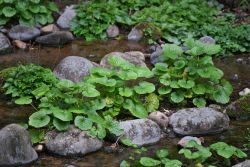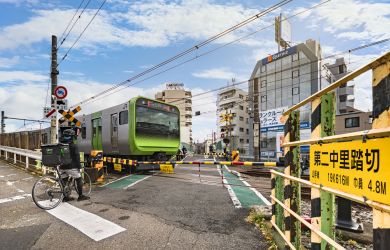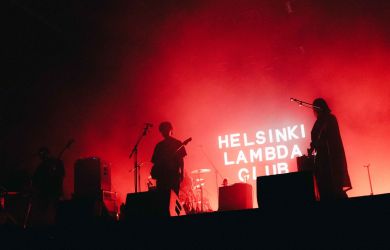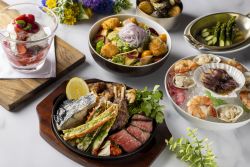
Originally published on metropolis.co.jp on August 2012


So, you’re going to Nikko for the beautiful natural setting and amazing historical sites far away from the hubbub of modern city life? Well you’re not alone—so did the Imperial Family. The Tamozawa Imperial Villa was the official residence of Japan’s divine dynasty when they escaped Tokyo’s burning summers, and today the building is maintained as an interesting display of their lifestyle there.
Empress Meisho first built the Tamozawa Villa in 1632 as a place for her relatives to live, connected to the temporary palace in Akasaka (in today’s Tokyo). In 1898, that three-storied section of the detached palace was taken apart and moved to its present-day location in Nikko, where it was enlarged into a new residence built around the same frame in 1899. The Taisho Emperor used it as his summer residence until 1925.
The Showa Emperor Hirohito fled to Tamozawa in 1943 after evacuation during World War II. Bomb shelters were built into the building’s gardens and can still be seen today (from the outside only, as access to the shelters is not permitted). Following the war, the villa fell into disuse and held no consistent official capacity until its restoration and re-opening as a museum in the year 2000.
Today, the complex is a fascinating tribute to Japanese architecture and history. Admittedly, that doesn’t sound like the most exciting way to spend an afternoon, but the displays and explanations have a way of bringing the past to life that are quite intriguing.
Tamozawa is one of the largest wooden buildings in Japan and uses many traditional methods of architecture and structure. A tour reveals the purpose and symbolism of those methods, deconstructing everything from the coffered gotenjo-style ceilings to the wall paintings, tatami and washi walls made of layers of paper. The gabled entrance to the villa was built in the uniquely Japanese karahafu style, a featured design that points back to the palace in Akasaka where the building originated.
The building is crafted around a series of beautiful courtyards. The outer gardens beside and behind it are beautiful and well worth exploring. A wander around will allow you to discover ancient trees and meticulously maintained landscaping. The jewel of the garden is a majestic 300-year-old weeping cherry tree. Positioned outside the Empress’s study, it presumably provided a good point of reflection.
The integration of the building’s layout with the courtyards was designed to promote airflow into the building and through its rooms to keep temperatures down in years before air conditioning. Many rooms are separated by lacquered ranma, wooden transoms that allow the cool air to circulate. Here, these feature designs thought to be modeled after examples in Kyoto’s Imperial Palace.

Each of the more than 100 rooms is also defined by their purpose during the Imperial Family’s stay. Visit the bedrooms of the Empress’s staff as well as the waiting room where nervous guests awaited their audience with the Emperor. Note the Western touches combined with traditional Japanese features in the dining room for distinguished guests, and see the pocketless billiard table used by notable historic figures to play a game called yotsudama (“four ball”).
The Tamozawa Imperial Villa is well equipped for non-Japanese-speaking visitors and—unusually for museums in this country—displays all information in several languages, including the introductory video at the entrance. The quality of the English is excellent.
As far as tourist attractions go, the Tamozawa Imperial Villa remains greatly overshadowed by the shrines, temples, and onsen of Nikko, the main draws of a region attracting over 3,000,000 visitors per year. Listed as a UNESCO World Heritage Site in 1999, the area contains some 100 buildings and structures belonging to Buddhist temple Rinno-ji and Shinto shrines Futarasan and Tosho-gu—the latter featuring a carving of the world-famous three wise monkeys who speak, hear, and see no evil. Set within the forests and mountains, Nikko is an historic and natural wonder that belongs among the must-see locations in Japan.
It’s easy to see why the Imperial Family chose the area as a holiday destination. Though we might have trouble finding accommodation as luxurious as the Tamozawa Villa, it remains a choice spot to cool off during the summer months.
inside information

Looking for other sights to see around Nikko? Put these on your travel itinerary.GOOD FOR YUBA
Nikko’s local delicacy is yuba, the thin skin that forms on the top of heated soy milk. Originally gaining popularity here as a dish to satisfy the vegetarian monks at the shrines and temples, yuba dishes can be found in restaurants citywide in a wide variety of forms. You’ll find yuba as a topping for soba, deep-fried yuba, yuba curry, yuba with jelly, yuba soup, yuba sushi, yuba ramen, yuba gyoza, and fresh, unprocessed (nama) yuba. It’s when the convenience stores start selling yuba cola that we’ll know things have gone too far.
INTO THE ABYSS
The Kanmangafuchi Abyss is a neat little gorge tucked within a twist of the Daiya River. The scenic riverside trail leads to the Bake Jizo, a line of 70 red-clad stone statues of Jizo, a Buddhist figure who cares for the deceased. The statues are rumored to change in number each time you count them. There’s some great natural beauty here as well, but bottomless pit seekers will be disappointed at the area’s misleading name.
FALLING FOR NIKKO
Just up the road from the Tamozawa Imperial Villa is the Nikko Botanical Gardens, a 105,000m2 patch of natural beauty typically free of the tourist crowds of other Nikko attractions. The University of Tokyo studies and maintains the 2,200 species of plant life here, which are set against a mountainous backdrop and are most beautiful set with the fall colors.
ICE A FEW BUCKS
If you’re visiting in autumn or winter, see the pucks fly and the gloves drop with the HC Nikko Ice Bucks. This professional ice hockey team gets die-hard support from the locals in the way only small-town teams can. The Ice Bucks compete against other teams from Japan, China and Korea in Asia League Ice Hockey. The Nikko Kirifuri Ice Arena hosts a little under 2,000 punters (including a standing-only section for spectators on a budget) and really gets rockin’ on game days.
CHASING WATERFALLS
Take a bus from Nikko to nearby Chuzenjiko Onsen, a quaint resort town built in the mountains above Nikko and on the shore of Lake Chuzenji. Its breathtaking scenery makes it well worth exploring for an afternoon. Visit the stunning Kegon Waterfall, Chuzenji Temple (pictured, above) take a sightseeing boat ride on the lake, or hike around the numerous walking paths. As the name suggests, there are many hot springs to be enjoyed as well.

trip tips
Take the Tobu Nikko Line from Asakusa to Nikko. Certain trains run nonstop to Nikko in the morning and to Asakusa in the afternoon. Alternatively, the JR Nikko Line directly connects Nikko from Utsunomiya, which can be reached from Ueno by either the JR Utsunomiya Line or Tohoku Shinkansen.





